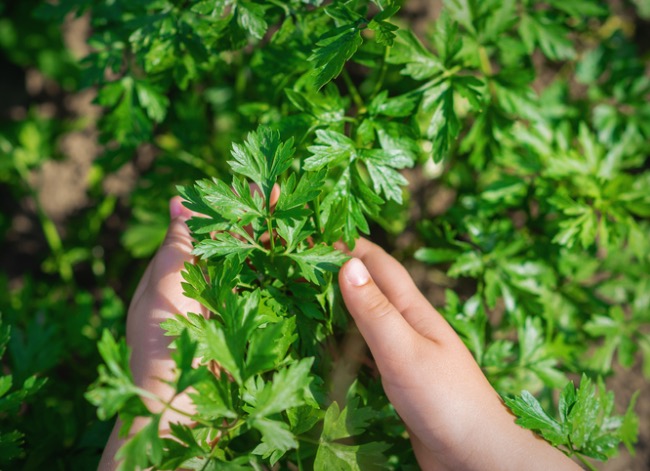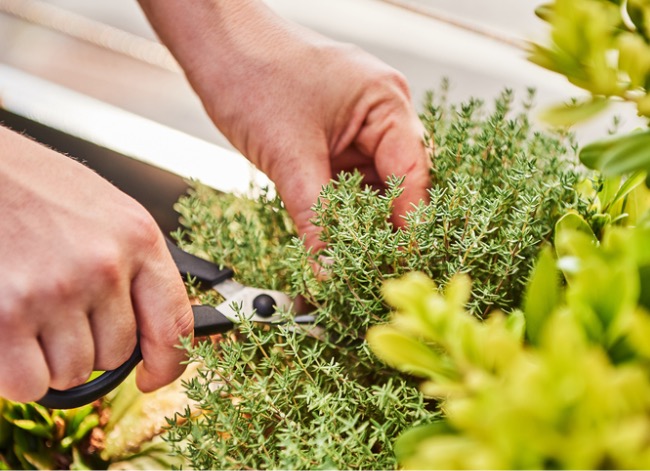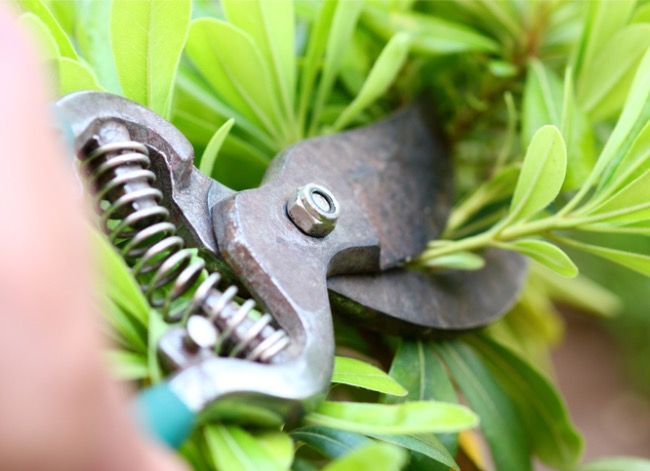We may earn revenue from the products available on this page and participate in affiliate programs. Learn More ›
Culinary herbs are some of the easiest and most rewarding plants to grow in the garden. They tolerate a wide range of soil conditions, grow easily either in the ground or in containers, and many are drought tolerant. The best part of growing fresh herbs, however, is that they are productive and useful. You can enjoy homemade pesto, herbal tea, salads, vinaigrettes, and attractive countertop arrangements, spring through fall, from just a few well-tended plants. The key to this bounty lies in cut-and-come-again harvesting techniques.
A plant’s main goal is to grow to maturity, make flowers, and produce seeds. With herbs, we mostly use the leaves, which become far less common once the plants begin to flower. Plucking individual leaves does little to boost an herb’s production. It may seem counterintuitive, but you actually have to cut it back harder to extend its productive life.
RELATED: The Best AeroGarden to Bring Your Garden Indoors
How to Pick Herbs
The right pruning methods gently interrupt the maturation of the plant, causing it to produce more foliage instead of flowers and seeds. Cooking herbs can be herbaceous or woody; annual, biennial, or perennial. Each kind of herb requires slightly different harvest techniques that are determined by its life cycle, growth habit, and branching pattern. Just ahead we’ll detail the proper cut-and-come-again pruning techniques for a few of the most popular herbs.
Basil
Basil is an herbaceous annual in the mint family. If not pruned it grows from seed, produces flowers, and goes to seed in as little as two months. Don’t let that happen. To maintain a bushy basil plant all season long, use herb pruners or scissors to cut the stems just above a set of leaves. Prune weekly, after the second set of true leaves appear. Once every four to five weeks, rejuvenate the entire plant by cutting it off just above the lowest set of leaves.

RELATED: 9 Ways to Rid Your Garden of Japanese Beetles
Chives
Chives are clumping perennial onions that grow quickly in spring and summer. Prune them just above the soil line monthly, and they will regrow throughout the season. To have a steady supply for cooking, either plant several containers, or harvest a single container one-third or one-fourth at a time.
Parsley
Biennial parsley grows from seed the first year, then flowers and goes to seed during its second growing season. Keep the plant neat, tidy, and vigorous by regularly cutting it back when it is at least 6 inches tall and each branching stem has three leaf segments. Prune the main leaf stems at the base where they join the clump.

RELATED: So, You Want to… Plant an Herb Spiral Garden
Rosemary
Rosemary is a woody perennial or shrub, with evergreen foliage. The best flavor and texture for cooking are found in its young, flexible stem tips. Harvest 6-inch branch tips from early spring through fall for immediate use or for drying. Avoid cutting into woody or leafless stems. Early in the growing season, cut back established shrubs by one-third to rejuvenate the plant and stimulate plentiful shoot production.
Oregano
Oregano is a low-growing, woody, deciduous perennial. Its spreading habit and thin woody stems present a few challenges. Prune too hard and the stems may grow back long, thin, and weak. If you don’t prune them, they become woody. As soon as the stems show signs of life in spring, remove dead branches. Then cut back the remaining plant by half its height. Throughout the growing season, harvest 2- to 3-inch stem tips as needed for culinary use.

What to do with the extras
When you prune to stimulate growth, you may end up with more herbs than you can use right away. Don’t let this good stuff go to waste. Of course you could compost the extra bits and pieces, but often you’ll have more substantial quantities. Why not dry them for winter use? Bundle the surplus into ready-made seasoning kits for soups, stews, herbal teas, and dressings.
RELATED: How to Make Homemade Mosquito Repellent: 6 Easy, Effective Recipes


